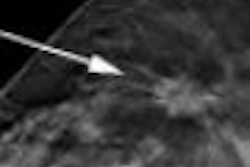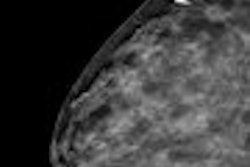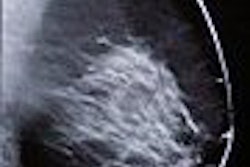Reimbursement for digital mammography can be daunting to deal with, especially as private payors and the government tighten their belts. And the reality of declining reimbursement can make or break a facility's bottom line when it comes to the decision of whether or not to go digital.
Digital mammography may be clinically accepted, but it's still unclear for many facilities whether it's a good idea. It pays to be realistic about exactly how much it will cost to set up digital mammography, about a facility's consumer and payor mix, and about how many exams the practice can reasonably perform per day, according to Dr. Michael Linver, vice president of the National Consortium of Breast Centers (NCBC) and a practicing radiologist at X-Ray Associates of New Mexico in Albuquerque. Linver gave attendees of NCBC's annual conference, held in March in Las Vegas, a sobering reality check on digital mammography.
Digital mammography and the DRA
Although the U.S. Congress voted in 2007 to prevent a 10% drop in Medicare physician reimbursement until this July, it also voted not to modify the Deficit Reduction Act (DRA) of 2005, legislation that reduces imaging reimbursement by $2.8 billion over five years.
Under the DRA, the technical component reimbursement for nonhospital imaging is reduced to the lesser of the Hospital Outpatient Prospective Payment System (HOPPS) or the Medicare Physician Fee Schedule (MPFS) payment; reductions vary from 4% to 37%. The good news for mammographers is that diagnostic and screening mammography is excluded from this provision.
So how does Medicare mammography reimbursement fare, both film-screen and digital? In the overall scheme of things, not too bad, according to Linver.
"The most consistent and highest digital mammography payor is still Medicare," Linver said.
Film-screen mammography: Medicare reimbursement rates 2008
|
Digital mammography: Medicare reimbursement rates 2008
|
The reimbursement history of digital mammography with other payors has been poor, according to Linver, although things have improved since the Digital Mammographic Imaging Screening Trial (DMIST) was published in 2005.
A large group of payors still reimburse digital mammography at the same rate as film-screen, using the argument that the DMIST overall results were the same for both technologies and, therefore, paying more for digital is unmerited, Linver said. And of course, there is another group of payors that reimburse digital mammography at rates lower than Medicare but higher than film-screen rates.
CAD conundrum
When the New England Journal of Medicine published an article last year claiming that computer-aided detection (CAD) actually has a negative effect on screening mammogram interpretation, a few payors, including ODS Companies of Portland, OR, and UnitedHealthcare of Minneapolis, moved to stop paying for the exam. ODS reversed its decision, but UnitedHealthcare stopped paying for CAD in January of this year, Linver said.
Many other payors currently don't pay for digital CAD, and Linver expects this trend to continue.
"Despite a flurry of new articles documenting the value of CAD, reimbursement for the technology will likely disappear completely by 2010," he said.
The true cost of going digital
Digital mammography is still quite expensive, with start-up costs for a first unit coming in at $500,000 to $700,000, above and beyond PACS costs, Linver said.
- Digital radiography (DR) unit: between $250,000 and $350,000 (a computed radiography [CR] setup can be between $150,000 and $250,000)
- 5-megapixel monitors: $50,000 (sometimes part of the workstation)
- Workstation: $100,000
- High-quality printer: $75,000
- Yearly service contract: $35,000 to $50,000
- CAD unit: $75,000
- Data storage: $5,000
Film-screen start-up costs, by comparison, are approximately $200,000:
- Mammography unit: $50,000 to $70,000
- Yearly film costs for 25 cases per day: $70,000
- Yearly service contract: $5,000
- Processor and supplies: $30,000
- CAD unit: $50,000
The difference between digital and analog start-up costs ranges between $300,000 and $500,000. How does a practice or facility make up the difference?
If a practice can do 50 cases per day on one machine and get paid at the full Medicare digital mammography rate, earnings can be $500,000 more per year. And in theory, digital mammography requires one less technologist, technologist aide, and file room administrator, for a savings of about $100,000 -- but it does require almost one more full-time radiologist, for a $200,000 to $400,000 loss, Linver explained.
High-volume practices often assume that with the $300,000 to $500,000 greater start-up costs of digital, and additional yearly revenue of $200,000 to $400,000, the practice should be able to recoup its initial investment by the second year. However, this scenario assumes a 70% increase in volume per machine (those 50 digital cases a day) and reimbursement at the Medicare rate of $50 more for each digital case.
"This is not happening in most places," Linver said.
He gave conference attendees suggestions for how to actually achieve profitability with digital mammography, including the following:
- Determine whether payors will pay extra for digital mammography.
- Maximize the department's efficiency and prepare to spend more time reading mammograms.
- Identify a benefactor, such as a hospital or foundation, that is willing to fund full-field digital mammography (FFDM) to attract revenue from breast cancer treatment.
- Buy CR rather than DR.
- Negotiate for CAD at lower cost.
- If buying MR or CT equipment, negotiate discounts on FFDM with vendors.
- Work with vendors to develop efficient FFDM interpretation workflow.
- Make sure that the vendor's financial scenarios are appropriate for your market, payor mix, and realistic volume levels.
- Wait for FFDM prices to come down even more (although there is a risk of market erosion in waiting).
But even the savviest radiology practices are at the mercy of the Centers for Medicare and Medicaid Services (CMS), Linver said: DMIST trial data showed that film-screen mammography found 26% more cancers than digital mammography in women with fatty breasts, a characteristic common in women of Medicare age. This may lead CMS to declare that because film-screen is more accurate in fatty breasts, paying more for digital doesn't add up, Linver said.
So is digital a good thing to pursue from a financial standpoint right now? Maybe yes, maybe no, according to Linver.
Digital mammography makes sense "if you have the right size and type of practice, if you have the right consumer market and payor mix, and if the government doesn't decrease Medicare reimbursement for digital to film-screen rates or lower," he said.
By Kate Madden Yee
AuntMinnie.com contributing writer
May 23, 2008
Related Reading
Making dollars and sense out of Medicaid and FFDM reimbursement, December 20, 2007
FFDM makes headway as primary breast cancer screening modality, November 27, 2007
Walking the tightrope: The legal and regulatory impact of digital mammography, October 11, 2007
Positioning is the key to making the most of FFDM, October 10, 2007
Top 10 considerations for FFDM and PACS integration, October 4, 2007
Copyright © 2008 AuntMinnie.com



















